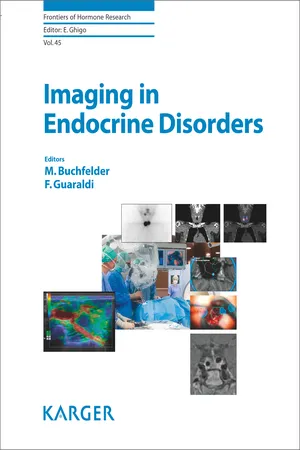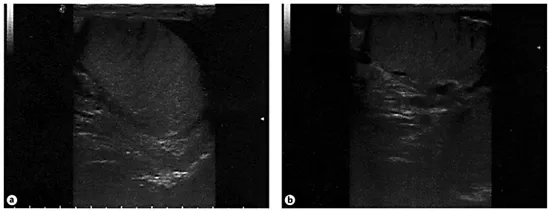
eBook - ePub
Imaging in Endocrine Disorders
- 156 pages
- English
- ePUB (mobile friendly)
- Available on iOS & Android
eBook - ePub
Imaging in Endocrine Disorders
About this book
Revolutionary changes in medical imaging have enormously improved the ability to detect structural and functional organ alterations early. Imaging is becoming an essential tool - in association with hormonal assays - for the diagnosis and management of endocrine disorders. New contrast media and their application to ultrasounds, as well as the opportunity to merge images acquired by functional/metabolic and traditional techniques, allow characterization of key features of identified lesions. Some radiological techniques such as ultrasonography, CT, and MRI are now available in operating rooms, thus supporting a diagnostic and therapeutic approach to endocrine diseases. In this new book, distinguished experts have contributed concise and well-illustrated chapters to describe pathognomonic features of several benign and malignant diseases affecting endocrine glands. They review the main advantages and disadvantages of each diagnostic technique along with indications for selecting a method. As a special feature, online videos of dynamic diagnostic and therapeutic procedures are available. Imaging in Endocrine Disorders is a must read and valuable reference for all professionals dealing with endocrine disorders, including internists and general practitioners who must manage the essential diagnostic workup.
Frequently asked questions
Yes, you can cancel anytime from the Subscription tab in your account settings on the Perlego website. Your subscription will stay active until the end of your current billing period. Learn how to cancel your subscription.
No, books cannot be downloaded as external files, such as PDFs, for use outside of Perlego. However, you can download books within the Perlego app for offline reading on mobile or tablet. Learn more here.
Perlego offers two plans: Essential and Complete
- Essential is ideal for learners and professionals who enjoy exploring a wide range of subjects. Access the Essential Library with 800,000+ trusted titles and best-sellers across business, personal growth, and the humanities. Includes unlimited reading time and Standard Read Aloud voice.
- Complete: Perfect for advanced learners and researchers needing full, unrestricted access. Unlock 1.4M+ books across hundreds of subjects, including academic and specialized titles. The Complete Plan also includes advanced features like Premium Read Aloud and Research Assistant.
We are an online textbook subscription service, where you can get access to an entire online library for less than the price of a single book per month. With over 1 million books across 1000+ topics, we’ve got you covered! Learn more here.
Look out for the read-aloud symbol on your next book to see if you can listen to it. The read-aloud tool reads text aloud for you, highlighting the text as it is being read. You can pause it, speed it up and slow it down. Learn more here.
Yes! You can use the Perlego app on both iOS or Android devices to read anytime, anywhere — even offline. Perfect for commutes or when you’re on the go.
Please note we cannot support devices running on iOS 13 and Android 7 or earlier. Learn more about using the app.
Please note we cannot support devices running on iOS 13 and Android 7 or earlier. Learn more about using the app.
Yes, you can access Imaging in Endocrine Disorders by M. Buchfelder,F. Guaraldi,M., Buchfelder,F., Guaraldi, Federica Guaraldi,Giovanni Corona,Federica, Guaraldi,Giovanni, Corona in PDF and/or ePUB format, as well as other popular books in Medicine & Diagnostics Imaging. We have over one million books available in our catalogue for you to explore.
Information
Buchfelder M, Guaraldi F (eds): Imaging in Endocrine Disorders.
Front Horm Res. Basel, Karger, 2016, vol 45, pp 80-96 (DOI: 10.1159/000442319)
Front Horm Res. Basel, Karger, 2016, vol 45, pp 80-96 (DOI: 10.1159/000442319)
______________________
Gonadal Imaging in Endocrine Disorders
Fabio Lanfranco · Giovanna Motta
Divisione di Endocrinologia, Diabetologia e Metabolismo, Dipartimento di Scienze Mediche, Università di Torino, Turin, Italy
______________________
Abstract
Ultrasound (US) is the most widely available method of diagnostic imaging for the evaluation and characterization of gonadal lesions and is usually the method of choice because of its high accuracy, low cost and wide availability. Today’ s high-resolution images allow for a confident diagnosis of many scrotal and adnexal lesions, with high sensitivity and specificity. Magnetic resonance imaging (MRI) is reliable in the detection of gonadal lesions in males, allowing the differentiation into testicular or nontesticular lesions, and their characterization. It is also an accurate and cost-effective diagnostic adjunct in those patients with solid scrotal lesions for whom the findings of clinical and US evaluations are inconclusive. In females, MRI is recommended as a second-line investigation for the characterization of complex adnexal masses that are indeterminate on US. In this review, gonadal pathologies related with the steroidogenic and gametogenic function of the testes and ovaries will be discussed. The main imaging features of benign and malignant lesions will also be presented.
© 2016 S. Karger AG, Basel
Male Gonads
Introduction
Scrotal ultrasound (US) is the most widely available method of diagnostic imaging and is usually the method of choice for examining the scrotum because of its high accuracy, excellent anatomic depiction, low cost and wide availability [1, 2]. Recent technical advances of US applications and postprocessing developments have enabled new aspects in the structural and functional analysis of testicular tissue and can suggest a specific diagnosis for a wide variety of testicular diseases [3].
Magnetic resonance imaging (MRI) is reliable in the detection of scrotal lesions, allowing the differentiation into testicular or nontesticular lesions and their characterization, including cysts and fluid, solid masses, fat and fibrosis [4]. MRI is an accurate and cost-effective diagnostic adjunct in those patients with solid scrotal lesions for whom the findings from clinical and US evaluations are inconclusive [5].
CT (computed tomography) scan is not commonly used in testis imaging because it involves ionizing radiation and because it is expensive. However, it can play an important role in testis cancer staging and in cryptorchidism in order to localize undescended testes [6].
In this section, scrotal pathologies related with the steroidogenic and spermatogenic functions of the testes will be discussed. For a more comprehensive overview of other benign and malignant testicular or extratesticular scrotal lesions the reader is referred to recent reviews such as those by Appelbaum et al. [2], and Pearl and Hill [7].

Fig. 1. a Sagittal view of the normal anatomy of the testicle, epididymis and mediastinum testis; reproduced with permission from Köpf-Maier [44]. Transverse (b) and longitudinal (c) US images showing a normal testis (T), epididymis (E) and mediastinum testis (arrow). d Transverse view of both testes for comparison of size, shape and echogenicity.
Normal Anatomy of the Scrotum
The normal postpubertal testes are symmetric and ovoid, and measure approximately 5 × 3 × 2 cm (fig. 1a). On US examination, the testis usually has medium level homogeneous echoes (fig. 1b-d), although normal variants have been described and include a unilateral striated pattern, thought to represent fibrosis (fig. 2), or hypoechoic intratesticular bands in the middle third of the testis which may contain arterial and venous components and represent a normal variant of intratesticular vessels. The fibrous tunica albuginea, which surrounds the testis, can be seen as a thin echogenic line [7].
The epididymis is a 6- to 7-cm tubular structure that normally courses inferiorly along the posterior aspect of the testis and is composed of a head, body and tail. The epididymal head measures 5-12 mm in diameter, is located at the superior pole of the testis and is round, triangular or pyramidal in shape [7, 8]. The body and tail are narrower, measuring 2-5 mm in diameter [8], and gradually taper as they course inferiorly along the testis to its lower pole (fig. 1a).
Testicular flow is supplied primarily by the testicular arteries, which arise from the aorta distal to the renal artery, course through the inguinal canal along the spermatic cord and reach the upper pole of the testes to divide into capsular arteries [2] (fig. 1a). On color Doppler US (CDUS) normal testicular tissue shows a typical stellar vascular pattern [3].

Fig. 2. Longitudinal (a) and transverse (b) US scans of a normal striated testis.
The epididymis and the extratesticular tissues are supplied by the deferential and cremasteric arteries. Venous drainage is accomplished by the pampiniform plexus, which drains into the ipsilateral testicular vein and subsequently into the inferior vena cava on the right or the renal vein on the left testis (fig. 1a).
Scrotal Ultrasound: Technique of Examination
The patient lays supine with the scrotal sac supported by a draped towel over the thighs and the penis covered with a towel over the pubis. A large amount of gel is applied over the scrotal sac [2]. For structural analysis mainly grayscale or B-mode US with a high-resolution, near-focused, linear-array transducer with a frequency of 7.5-14 MHz or greater is used. Bilateral transverse and longitudinal slices of the scrotum and inguinal region are performed to allow side-to-side comparison of their sizes and echo texture [3]. Any intratesticular or extratesticular finding should be imaged and measured in different planes [2].
Grayscale US is mainly used for the measurement of testicular volume and for estimation of tissue texture based on alterations in echogenicity. This technique demonstrates the alteration of size and echogenicity in an atrophic testis as well as alteration of echogenicity in a testis with partial infarction or ischemia in comparison to normal testicular tissue. A slightly impaired echo texture indicates a decreased testicular function. Testicular volume in infertile men is related to semen profiles. Up to 70-80% of the testicular volume consists of the seminiferous tubules and reflects spermatogenesis [3]. A strong correlation between testicular function and testicular volume measured by US or other techniques has been proven by Sakamoto et al. [9]. For further functional analysis the native or unenhanced CDUS, the contrast-enhanced CDUS and the advanced contrast agent detection techniques like MVI (microvessel imaging, Philips) and the calculation of TIC (time intensity curve) are implemented [3].
Unenhanced CDUS is well established to illustrate macrovascularity and therefore perfusion. Testicular perfusion can be evaluated with color Doppler, power Doppler and spectral Doppler US [3]. CDUS and power Doppler US represent a promising method for the assessment of patients affected by azoospermia by allowing the discrimination of obstructive azoospermia (normal vessel distribution) from nonobstructive azoospermia (reduced or absent testicular vessels) [3].
Contrast-enhanced US (CEUS) can be used for the illustration of macrovascularity and microvascularity. For this, micro bubbles with a lipid or galactose shell filled with an inert gas and a diameter of 7-10 μm are administered intravenously. These microbubbles can be used as an echo enhancer for CDUS leading to a visualization of blood flow also in the microvessels [3]. Thierman et al. [10] found out that CEUS is potentially applicable to the investigation of vascular disorders of the testis. The use of a pulse inve...
Table of contents
- Cover Page
- Front Matter
- Sonography of Normal and Abnormal Thyroid and Parathyroid Glands
- Computed Tomography and Magnetic Resonance Imaging of the Thyroid and Parathyroid Glands
- Role of Nuclear Medicine in the Diagnosis of Benign Thyroid Diseases
- Hybrid Molecular Imaging in Differentiated Thyroid Carcinoma
- Endoscopic Ultrasound in Endocrinology: Imaging of the Adrenals and the Endocrine Pancreas
- Adrenal Imaging: Magnetic Resonance Imaging and Computed Tomography
- Adrenal Molecular Imaging
- Gonadal Imaging in Endocrine Disorders
- Magnetic Resonance Imaging of Pituitary Tumors
- Intraoperative Magnetic Resonance Imaging for Pituitary Adenomas
- Molecular Imaging of Pituitary Pathology
- Imaging of Neuroendocrine Tumors
- Author Index
- Subject Index